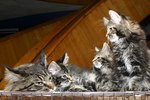Persian cats are prone to a variety of skin problems. Some of these conditions and diseases can range from mild to severe and some also affect other breeds of cats. In order to properly diagnose any skin condition, your veterinarian will need to take skin samples, such as a skin scraping, in order to examine for bacteria, fungi, mites or other issues.
Dermatophyte Infections
A dermatophyte infection is a fungal infection with four different species that may cause the initial infection. Persian cats are especially prone to dermatophyte infections. One species, better known as ringworm, is actually a dermatophyte infection. Many people assume that ringworm is an actual worm, however its actually a fungus that grows on the skin. (See Reference 1.)
In the case of ringworm, the fungus lives within the hair follicles of the cat. Eventually hair loss will occur and a large, round lesion will be left in its place. There may also be a crusty layer surrounding the lesion. (See Reference 1.)
Feline Eosinophilic Granuloma Complex
Eosinophilic granuloma complex is actually a collection of three reactions in cats. Usually two or more of the three types are present at one time in the cat. The three types, known as indolent ulcers, eosinophilic plaque and eosinophilic granuloma, affect different parts of the body. Indolent ulcers usually occur in the mouth, particularly the upper lip. (See Reference 2.)
Meanwhile, eosinophilic granuloma and eosinophilic plaque can both affect parts of the skin. Eosinophilic granulomas occur on the thighs, the pads of the feet, around the face and even in the oral cavity. Eosinophilic granulomas are often associated with a swollen lower lip or chin and may have a sprinkling of small white lesions inside or around the mouth. (See Reference 2.)
Eosinophilic plaque causes lesions that occur on the skin but are most often seen on the torso and thighs. These plaques can be round to ovular in shape and are raised above the surface of the skin. Hair loss is also common in and around these plaques. (See Reference 2.)
Acne
Acne is also relatively common in Persian cats, particularly in the form of blackheads. The blackheads are similar in appearance to flea dirt. Fortunately, acne is fairly easy to treat. Medications such as antibiotics or corticosteroids may help, in addition to shampoos that contain benzoyl peroxide. (See Reference 3.)
Blackheads may also be a reaction to plastic bowls, so you may want to consider switching to stainless steel bowls or ceramic bowls. (See Reference 3.)
Idiopathic Persian Facial Dermatitis
Persians are prone to more severe cases of acne, referred to as idiopathic Persian facial dermatitis. When this condition occurs, the face becomes encrusted with a black, wax-like substance around the chin and the eyes. Due to the flattened face of the Persian, it is not unusual for water and food to get stuck in the fur and the folds of the face, causing mild acne. Cleaning the face after feeding may help prevent this. As with acne on the chin, plastic bowls may also be a partial culprit. (See Reference 3, Resource 1.)
Mange
As with all cats, Persian cats can also develop mange. Mange is caused by mites that get into the skin and cause infections. Certain forms of mange, such as demodectic mange can cause itchy lesions on the skin. Other forms of mange, such as notoedric mange or ‘feline scabies’ can cause hair loss, excessive itching and more. The mites that cause notoedric mange usually begin on the face or ears and spread throughout the rest of the body. (See Resources 2, 3.)



